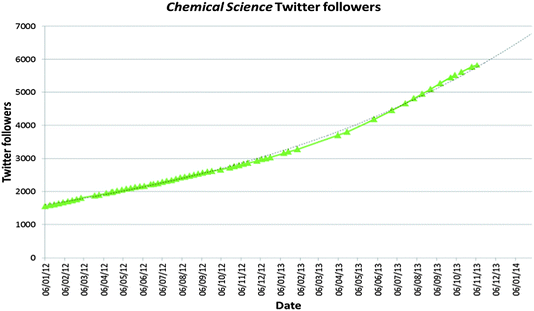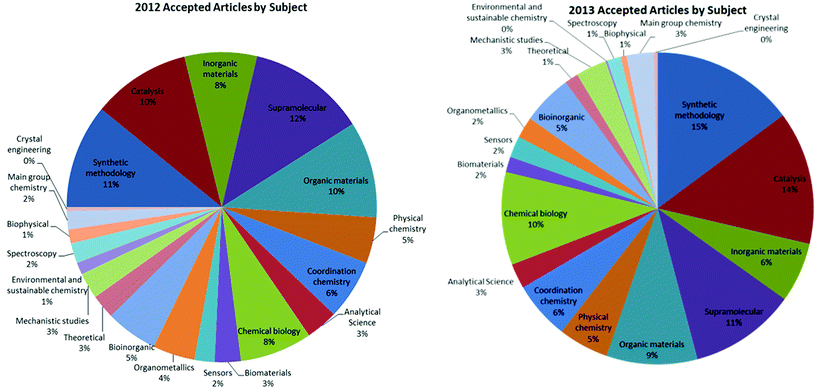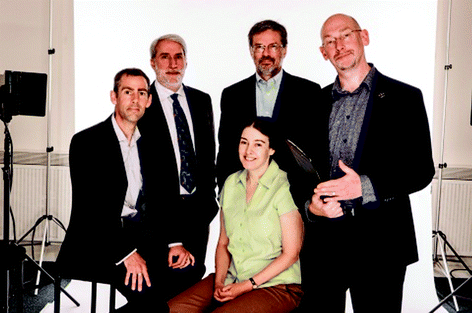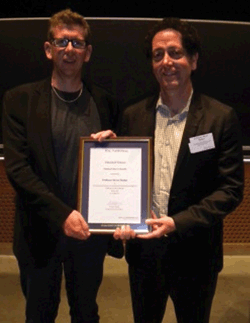Chemical Science editorial
Abstract
In this Editorial, we look back at a successful 2013 and forward to a landmark 5th year for the journal.
2013
We are delighted that 2013 has proved to be such a successful year. In keeping with Chemical Science celebrating its 5th year in 2014, we first highlight the top 5 achievements for 2013.5 Maintaining a community focus
A major driver for the launch of Chemical Science was the volume of community feedback we received highlighting the need for the Royal Society of Chemistry to launch a flagship general chemistry journal. Maintaining strong links with the international chemical community therefore, remains a key part of our strategic plan. To achieve this we have supplemented the traditional methods of outreach such as conference attendance and university visits with tools such as Twitter, and more recently Facebook. These new powerful methods have helped us engage with new audiences and ensure Chemical Science remains relevant to a wide range of scientists. Our growth in the number of Twitter followers (Fig. 1) and Facebook likes in 2013 has been significant, so if you are not connected, please do so (http://www.Twitter.com/chemicalscience or http://www.Facebook.com/chemical.science.journal). It's the best way to keep up to date with journal news, the latest exceptional research and what's going on in the Editorial Office.4 Something for everyone
We remain committed to delivering a journal that contains exceptional research from across the chemical sciences. In 2013, we retained clear strengths, in both submissions and acceptances, for articles covering organic, supramolecular and materials chemistry. The focus of the Editorial Board therefore has been to raise visibility and generate submissions from the chemical biology and physical chemistry communities. We will continue to increase the visibility of Chemical Science in these areas in 2014, but it is pleasing to see that the work we have done recently is already having an impact, particularly within the chemical biology arena (Fig. 2).3 International Symposium on Advancing the Chemical Sciences (ISACS)
As with Chemical Science, the ISACS series completed its 4th year in 2013. The focus of the events switched to challenges in supramolecular chemistry and organic materials (Kyoto, Japan), chemical biology (Boston, USA) and chemical renewable energy (Cambridge, UK). As always, the science presented was exceptional, with energetic discussion in both the main symposia and poster sessions. We extend our thanks and gratitude to Professors Susumu Kitagawa and Atsuhiro Osuka, Professor Ben Davis and finally Dr Erwin Reisner and Professor James Durrant for all their efforts as Scientific Chairs for the 2013 ISACS meetings.Two high profile events also took place at ISACS symposia in 2013. First in Boston, where Associate Editor Professor Tom Muir (Princeton University) presented Professor Kevan Shokat (UC San Francisco) with the inaugural Chemical Science Lectureship. Kevan received the lectureship for his pioneering research using the tools of synthetic organic chemistry, structural biology, genetics, and mathematical modeling to gain insight into how signaling networks transmit information in normal and disease settings. On behalf of the Editorial Board we would like to congratulate him once again on his continued outstanding research.
More recently, a live recording of the BBC World Service programme The Forum (http://www.bbc.co.uk/programmes/p004kln9) took place at ISACS 12, challenges in chemical renewable energy. The Forum, an ideas discussion show which tackles the big questions of our age with some of the world's most eminent minds, examined some of the current issues surrounding renewable energy. Quentin Cooper was joined by Jim Watson (Research Director, UK Energy Research Centre) and three plenary speakers from ISACS, Professors Daniel Nocera (Harvard), Clare Grey (Cambridge) and Brazilian authority on bioenergy Professor Carlos Henrique de Brito Cruz. The recording was a tremendous success and is still available to listen to, free of charge (http://www.bbc.co.uk/programmes/p01g94yj).
The ISACS series remains an integral part of the strategy for Chemical Science, both in terms of raising visibility and awareness, but also through the submission of exceptional research from speakers and attendees. Further details of the 2014 ISACS can be found later in this Editorial.
2 Citations and impact factor
June 2013 brought the exciting news of a 15% increase in Impact Factor from 7.52 to 8.31 (2012 Journal Citation Reports, Thomson Reuters 2013), a tremendous achievement in only the journal's 4th year. Chemical Science also received a new Immediacy Index value of 2.77. This is comparable to both the Journal of the American Chemical Society (JACS) and Angewandte Chemie but, most importantly, is a positive sign for future Impact Factors.An analysis of Chemical Science articles published in 2012 versus its competitors provides insight into how the journal is performing with respect to accumulating citations (Fig. 3). Chemical Science has been able to establish itself as a leading journal in the field, in a very short space of time, with comparable or better performance in most citation groups. This is a clear indication that the journal will only go from strength to strength in the future.
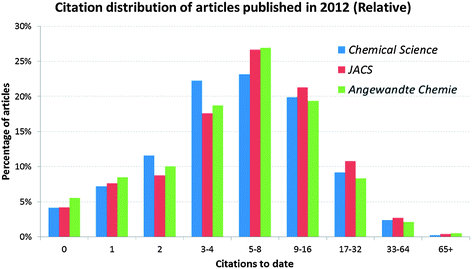 | ||
| Fig. 3 Citation distribution of articles published in 2012 for Chemical Science and its competitors (data taken from Web of Science, Thomson Reuters 2013 and correct as of 8th November). | ||
1 Only exceptional research will do
The quality of research published in Chemical Science remained the key focus in 2013. We would particularly like to thank all those involved with the peer review process. These combined efforts ensured that standards remained impeccably high, with respect to both scientific quality and rigour. With the rejection rate consistently around 85%, we know that the articles published in 2013 are of a standard befitting the Royal Society of Chemistry's flagship journal.We also extend a special thanks to Associate Editor, Professor Teri Odom for all her hard work and dedication since the journal was launched in 2010. Teri leaves for pastures new working as an Associate Editor for the new journal, ACS Photonics. Our new Associate Editor for nanoscience will be announced early in 2014.
2014
So what can you expect from Chemical Science in 2014?The number one priority for the Editorial Board will be to maintain the incredibly high standards you have come to expect from Chemical Science. Maintaining rigorous but fair review to ensure scientific accuracy is paramount, with the end result being cutting-edge research published from across the chemical sciences, supplemented by insightful Perspectives and Minireviews.
The next installments of ISACS covering Organic Chemistry (Shanghai, China – August), Inorganic Chemistry and Materials Chemistry (Dublin – July) and Nanoscience (San Diego, USA – August) are well underway. The plenary speaker programmes are now available at http://www.rsc.org/isacs so take a look and be impressed. If you are on Twitter you can follow us (@ISACSconference) and be notified of all the latest news and deadlines.
We will also continue the success of the inaugural Chemical Science Lectureship with the presentation of three in 2014. We plan to announce the recipients early in 2014, with one presented at each of the ISACS; so watch this space.
The Chemical Science Editorial Board will also be heading east next summer. Plans are well underway for the Editorial Board meeting and a two day symposium to be held at the Chinese Chemical Society Conference at Peking University, Beijing, China in early August.
And last but not least, to coincide with our landmark 5th year, Chemical Science has also had a facelift – we hope you like our fresh new look? We have ambitious goals and to reach them we want to build a greater awareness of Chemical Science and the Royal Society of Chemistry. We feel our new logo reflects the dynamic creativity of chemistry, it's about collaboration and community, becoming stronger as it builds and overlaps. What do you think? We'd love to hear your feedback, please share your thoughts with us E-mail: brand@rsc.org. As well as updating our logo and cover designs, we have also made some changes to the way our articles look to reflect the new brand, make an impact and most importantly make it easier for you to read and navigate.
We hope you will agree there is plenty more to come from Chemical Science!
And finally…
As is customary at this time, it is important we acknowledge all the people who have been involved with Chemical Science over the last 4 years. In particular, we would like to thank all our authors, referees, Associate Editors and the Cambridge editorial team for their dedication and support. We hope you will continue to work with us in 2014, as with your help, we can achieve our key objective of becoming the number one ranked journal for the chemical sciences.Wishing you all a happy New Year for 2014.
Professor David W. C. MacMillan, Editor-in-Chief.
Dr Robert D. Eagling, Managing Editor.
Miss Jane Hordern, Deputy Editor.
Miss Philippa Ross, Senior Publishing Editor.
| This journal is © The Royal Society of Chemistry 2014 |

